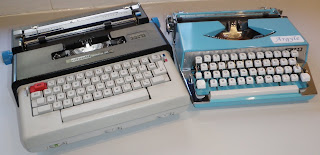JUNE 8
Ettore Sottsass and the Nippo P-100
OK, I’ve had a bit to say about Ettore Sottsass, especially in relation to the Olivetti Valentine. And I’ve also poked a bit of gentle fun at the Nippo typewriters, the so-called “rhismical” machines that many typewriter fanciers rate as one of the poorest, if not THE poorest, typing machines ever devised.So where is the connection? Well, believe it not, when Sottsass, on this day in 1970, was granted a US patent for his design for the outer casing of the Olivetti Lettera 36 electric portable (as portable as an electric typewriter can be), he used as one of his references the Nippo P-100 of 1966. (Maybe, after all, that's what Sottsass had in mind with his original concept for the Valentine.)
Now it was a very brief and to-the-point patent description, for a design assigned to Olivetti in Ivrea and already filed in Italy the previous year. Sottsass didn’t flesh out his use of his references. But apart from the Nippo P-100, he also referred to the Aztec 700 of 1965 (which we all know as an East German Erika) and the Remington Envoy of 1964.
And if anyone is able to tell me where the connections lie between the Nippo P-100, the Aztec 700/Erika and the Remington Envoy (also called several other model names, but the same machine) and the Olivetti Lettera 36, I’d like to hear from them. I can’t see it for the life of me.
Anyway, here are some photographs of my own Lettera 36, Remington Envoy (in this case a Reporter) and Nippo P-100 side-by-side, as well as an Aztec 700. At least the Olivetti and the Remington have the same colour combination.
Also on this day, in 1937, Ronald D.Dodge, of Rochester, New York, was granted a patent, assigned to IBM, for a typewriter which wrote on a tape (above). Dodge explained, “It is customary for radio and cable operators to use typewriters for transcribing radio and cable messages by typewriting the letters as fast as the code signals are received. When ordinary page printing typewriters are used, much time is lost in the insertion of sheets of paper and the returning of the carriage … Naturally this slows reception of messages an appreciable amount, particularly at times when the radio or cable traffic is heavy.
"It has been proposed to use standard typewriters equipped with tape feeding mechanism whereby the messages may be typed continuously on a narrow tape like the ones now used on tape printing automatic telegraph receivers. With such a machine a radio or cable operator can type the messages continuously and allow the tape to accumulate in a basket ... [the] tape can be pasted on suitable forms in the usual way.”
On this day in 1953, John W. Ehemann, of Chicago, filed a design, assigned to the Dial-Rite company of Battle Creek, Michigan, for improvements to the toy electric typewriter (above). Ehemann's explanation is interesting" “Toy typewriters, in the past, have universally been made of the mechanically operated type ... Those machines which have come on to the market during the past few years have used keyboards wherein bad typing habits, such as the one finger ‘hunt and punch’ system, acquired by the child or adult using them, have been harmful when he later started learning to properly use a standard typewriter. Such machines were also undependable, short lived in most cases, and commonly lacked means for uniformly spacing the letters appearing in a typed line, so that a crude typing job was the best that could be expected.”
I have seen ads for such a thing, but have never seen one for sale.
On this day in 1906, Theodore Roosevelt signed the Antiquities Act into law, authorising the President to restrict the use of certain parcels of public land with historical or conservation value. Mr Obama should consider a law protecting typewriters from keycutters. Above, for starters, is Roosevelt’s typewriter:
On this day in 1949, Helen Keller, Dorothy Parker, Danny Kaye, Fredric March, John Garfield, Paul Muni and Edward G. Robinson were named in an FBI report as Communist Party members. Keller (above, with a Hammond) and Parker (below)are seen using typewriters here. (By the by, I now own the Hermes 2000 once used by the Communist Party of Australia – a red-link typecast is on its way,)
Perhaps somewhat appropriately, given the above, also on this 1949 George Orwell's dystopian novel Nineteen Eighty-Four was published by Secker and Warburg in London.
In 1998, the Modern Library ranked Nineteen Eighty-Four 13th on its list of the 100 best English-language novels of the 20th century.
Here is Orwell at his Remington Model 1 portable:
Belgian-born French-American author, essayist and poet Marguerite Yourcenar was born Marguerite Antoinette Jeanne Marie Ghislaine Cleenewerck de Crayencour in Brussels on this day in 1903. She died in Northeast Harbor, Maine, on December 17, 1987, aged 84. She was the first woman elected to the Académie française, in 1980.


















2 comments:
Another great entry in this series.
It is interesting to see direct evidence that industrial designers were looking closely at each other's patented designs.
The inventions of the day are clever. Love the narrow little platen on the tape typewriter. The concept of an electric toy typewriter is probably doomed, due to parents' legitimate concerns about electrocution!
At the risk of saying something stupid--My Morse 900 is one of the best compact carriage-shifted typewriters I've ever used--it's like the Nippo factory fixed the bugs on the Royalite and added chrome! (I bought mine a couple of weeks ago in Spokane, and when I got back to Seattle, compared it to a Royalite, and the Nippo came out ahead!) Also, any ideas on serial number ranges for the Nippo?
Post a Comment